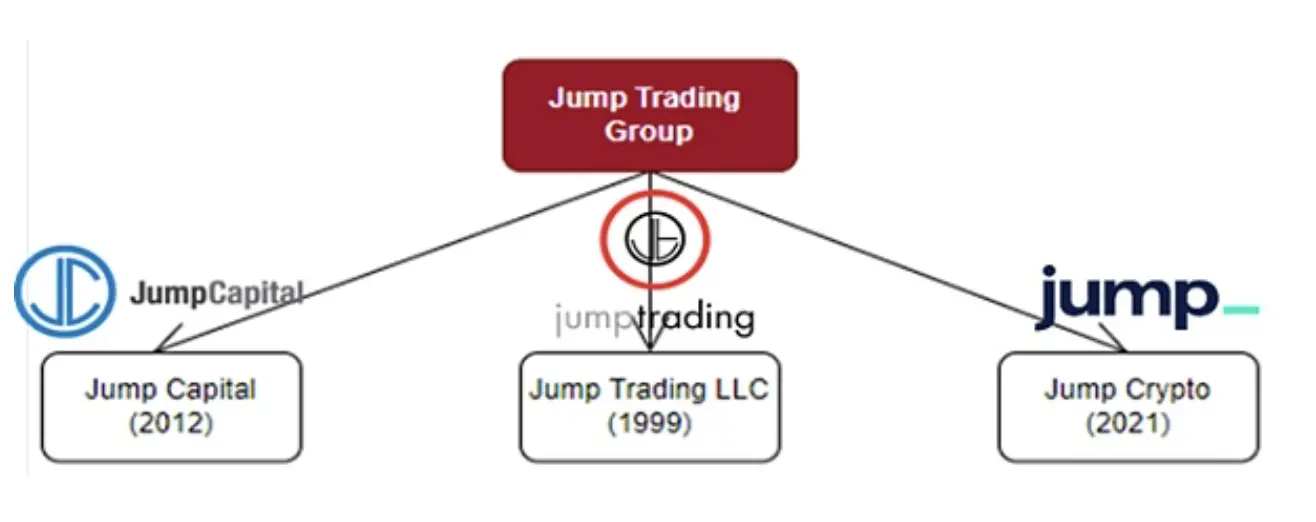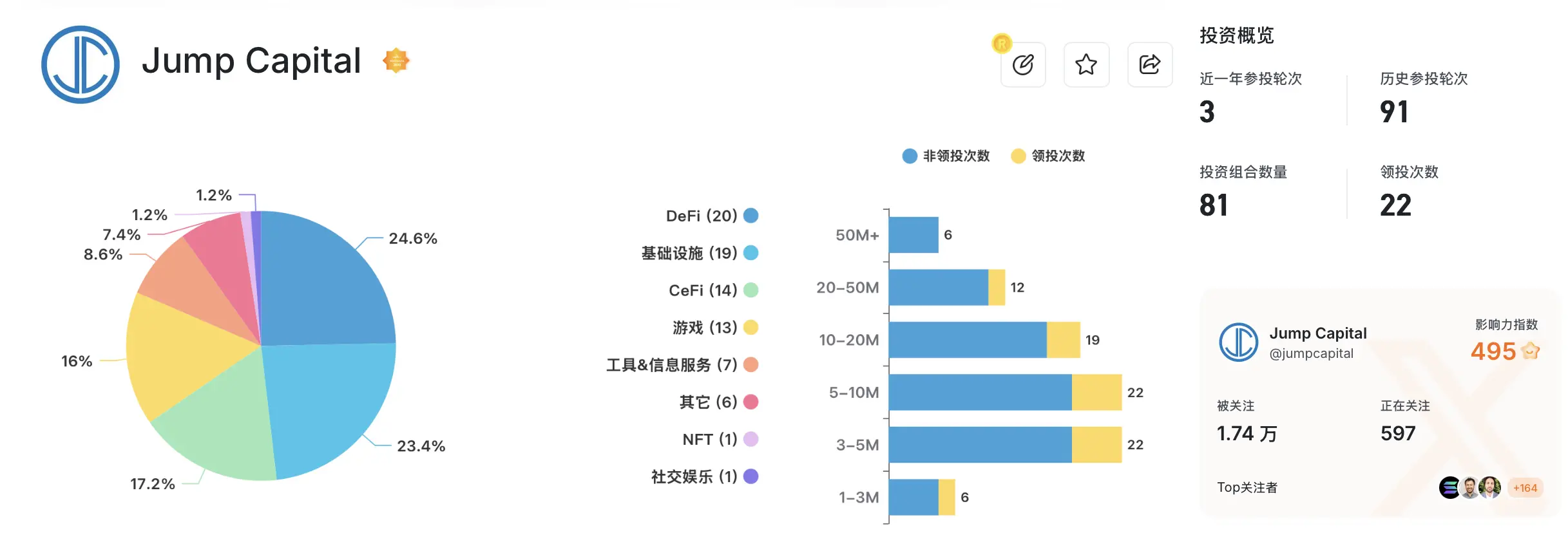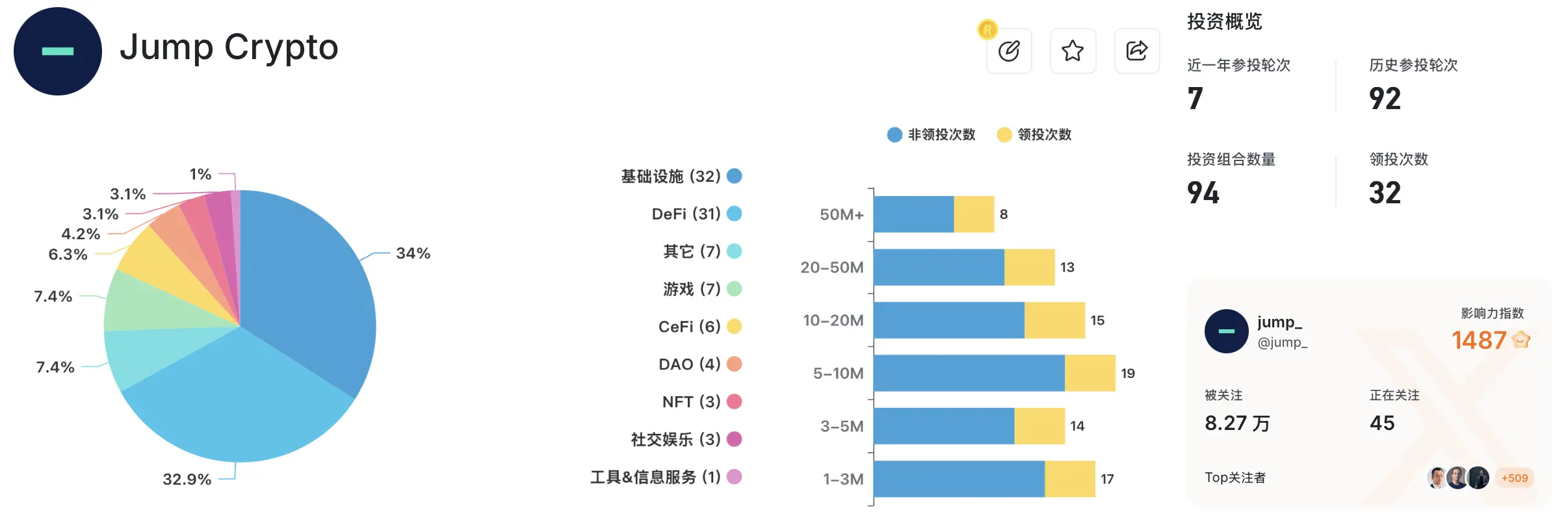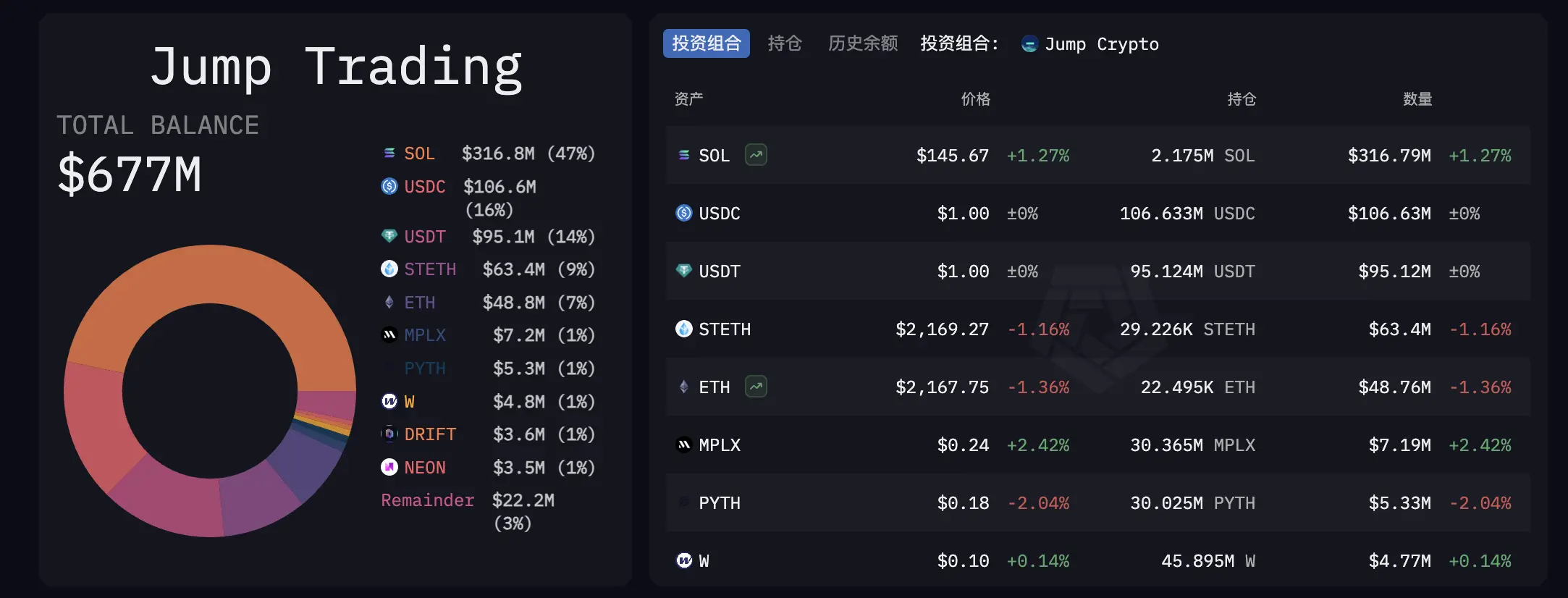Breaking into dark history, Jump fully restores its crypto business and falls into an embarrassing situation

Reprinted from panewslab
03/08/2025·2MAuthor: Nianqing, ChainCatcher
Last August, a rapid and huge sell-off from Jump Trading pushed the crypto market into the abyss, further triggering a "805 plunge". At that time, rumors about Jump's "this big guy" was about to fall were getting worse.
In the following six months, almost all the few news about Jump revolved around its internal and external litigation and lawsuits.
Recently, CoinDesk quoted people familiar with the matter as saying that Jump is currently fully resuming its cryptocurrency business. Jump Trading's official website shows that Jump is recruiting a group of cryptocurrency engineers for its offices in Chicago, Sydney, Singapore and London. In addition, another person familiar with the matter added that Jump plans to start supplementing U.S. policy and government liaison positions in due course.
Jump was once called the "absolute king" of the trading world. With ultra-low latency trading systems and complex algorithm design, Jump is one of the key liquidity providers in traditional finance. As the scale of the crypto market continues to expand, Jump began to make markets for cryptocurrencies and invest in crypto projects. Later, it officially established the crypto business department Jump Crypto in 2021.
However, a bet that accompanied Jump Crypto's birth also laid hidden dangers for its subsequent tragedy at that time.
Jump Trading: The secret giant's crypto bet
Early on, traders publicly shouted prices in trading halls through shouting, gestures and jumping. This is also the inspiration for the name of Jump Trading.
Headquartered in Chicago, Jump Trading was founded in 1999 by two former Chicago Mercantile Exchange (CME) traders Bill DiSomma and Paul Gurinas, and Jump soon grew into one of the world's largest high-frequency trading companies, active on futures, options and stock exchanges around the world, and is also a major trader for U.S. Treasury and cryptocurrencies.
Out of protection of trading strategies, Jump always keeps a low profile, and market makers have always been hidden behind the scenes, and there is always a veil of mystery surrounding it. Jump rarely releases its financial data, and its founders have been tight-lipped about its operating conditions. Since 2020, perhaps for the purpose of reducing exposure, Jump's adjustment of its strategy and business reorganization will no longer need to submit 13F documents to the SEC, and will continue to submit it by its parent company Jump Financial LLC. According to the latest 13F documents submitted by the latter, Jump Financial's asset management scale exceeds US$7.6 billion, and the number of employees is about 1,600. In addition, Jump Trading has offices in the United States, Europe, Australia and Asia.
Jump Trading also has two sub-business departments, namely Jump Capital and Jump Crypto.

Jump Capital
Headquartered in Chicago, Jump Capital was founded in 2012. Although Jump's crypto division was officially established in 2021, Jump Capital has been involved in investment in the crypto space very early. Peter Johnson, its partner and head of crypto strategy, revealed that the company has been secretly deploying crypto strategies for many years.
According to the relevant RootData page, Jump Capital has more than 80 crypto portfolios, mainly investing in DeFi, infrastructure and CeFi, and has invested in loTeX, Sei, Galxe, Mantle, Phantom and other projects.

In July 2021, Jump launched its largest fund since its inception, with a total capital commitment of $350 million, attracting 167 investors, the seventh venture fund of Jump Capital.
Jump Crypto
In 2021, while Jump completed the fundraising of its seventh investment fund, it announced the establishment of Jump Crypto, a crypto investment department, and invested 40% of the seventh investment fund in the cryptocurrency field, focusing on DeFi, financial applications, blockchain infrastructure and Web 3.0 stocks and tokens.
Kanav Kariya, who is only 26 years old, served as the first president of Jump Crypto in 2021. Kariya joined Jump Trading as an intern in early 2017 and was assigned by the company to build an early cryptocurrency trading infrastructure.
In May 2021, Terra's algorithmic stablecoin UST was deaned for the first time. In the following week, Jump secretly purchased a large amount of UST to create the illusion of a demand boom and pull the UST back to $1. The deal made Jump earn $1 billion, and his proposal, Kariya, was quickly promoted to president of Jump Crypto four months later.
But this secret transaction also laid the groundwork for Jump's fall into the altar.
With the complete collapse of the Terra UST stablecoin in 2022, Jump faces criminal charges for working with Terra to manipulate the UST currency price. In the same year, Jump suffered heavy losses in the bankruptcy of FTX due to its deep binding to the FTX and Solana ecosystems.
After the FTX incident, the United States tightened its supervision of the crypto market, and Jump Trading was reported to be forced to shrink its business and gradually withdraw from the US crypto market. For example, Robinhood stopped its partnership with Jump after the FTX incident, a subsidiary of Jump Crypto, which was once one of Robinhood’s largest market makers and was responsible for handling Robinhood’s billions of dollars in daily trading volume. But since the fourth quarter of 2022, Robinhood's financial report no longer mentions Tai Mo Shan, and Robinhood has instead cooperated with market makers such as B2C2.
In addition, in order to reduce its cryptocurrency business, in November 2023, Jump Crypto officially split Wormhole, and Wormhole CEO and COO resigned from Jump Crypto. The Jump Crypto team’s number also nearly halved during this period.
Jump Crypto's investment moves have also decreased significantly after 2023. According to the relevant RootData page, Jump Crypto's crypto portfolio has exceeded 90, mainly investing in infrastructure and DeFi, and has invested in projects such as Aptos, Sui, Celestia, Injective, NEAR, Kucoin, etc. But its "subscription rounds in the past year" only have single digits.

On June 20, 2024, according to Fortune, the U.S. Commodity Futures Trading Commission (CFTC) is investigating Jump Crypto. A few days later, Kanav Kariya, who had served in Jump Trading for six years, announced her resignation.
A month later, Jump Crypto started a massive ETH sell-off. Within 10 days, the cumulative ETH sold by Jump Crypto has exceeded US$300 million, and panic has directly led to the market decline on August 5, 2024, with Ethereum's largest single-day decline of more than 25%. The community speculates that Jump Crypto's sell-off on ETH may be due to pressure from the CFTC investigation in exchange for stablecoins to exit the cryptocurrency business at any time. Jump Crypto was once rumored that “this big guy is going to fall.”
Related reading: "Accused of causing market collapse, exposing crypto market maker Jump Crypto"
In December 2024, Tai Mo Shan, a subsidiary of Jump Crypto, agreed to pay approximately $123 million to settle with the U.S. SEC. According to later SEC allegations, it was Tai Mo Shan who participated in the UST market making in Terra that year. It is reported that Tai Mo Shan is registered in the Cayman Islands and is established to handle specific market making and cryptocurrency trading businesses.
The incident between Jump and Terra seems to have finally settled after more than three years of painful entanglement.
Jump fully restores encryption business: Is the return of the king or is
it difficult to return?
Jump Why choose to fully restore encryption services at this time?
Apart from Jump's judicial settlement on the Terra incident, a more critical reason is the Trump administration's friendly attitude towards cryptocurrencies.
Just two days ago, on March 5, Jump's Chicago-based rival DRW, Cumberland DRW, signed a joint application with the U.S. Securities and Exchange Commission (SEC), intending to revoke the lawsuit filed by the SEC. The agreement reached an agreement on February 20 on both sides and is currently awaiting approval from the SEC committee. The SEC sued Cumberland DRW in October last year, accusing it of operating as an unregistered securities dealer and selling more than $2 billion in unregistered securities.
The new SEC leadership team has adopted a more tolerant release policy for crypto companies, and this attitude has given Jump a hope of making a comeback. In addition, the possibility of altcoin spot ETFs such as Solana are approved this year makes Jump Crypto, which is deeply involved in the Solana ecosystem, want to get a share of it.
At the end of 2023, Jump had negotiated with BlackRock on "making market for Bitcoin spot ETFs", but perhaps due to regulatory issues, Jump Crypto ultimately did not participate in the market making of Bitcoin and even later Ethereum spot ETFs.
Jump still has the strength to make a comeback
A lean camel is bigger than a horse. Jump Trading still holds about US$677 million in on-chain assets, of which Solana tokens account for nearly half of the shares, and holds 2.175 million SOLs. Secondly, stablecoins account for about 30%.

Source: ARKHAM
Jump Trading's on-chain capital holdings are still the largest among several crypto market makers. As of March 8, 2025, Jump's position funds compared with other market makers are sorted from high to low:
- 1.Jump Trading: $677 million
- 2. Wintermute: $594 million
- 3.QCP Capital: USD 128 million
- 4.GSR Markets: $96 million
- 5.B2C2 Group: $82 million
- 6.Cumberland DRW: $65 million
- 7.Amber Group: $20 million
- 8.DWF Labs: $10 million
In addition, in addition to the size of funds, Jump also has a series of technical advantages. Taking deep participation in the Solana ecosystem as an example, Jump currently participates in the Solana ecosystem through technical development (developing Firedancer verification client, providing technical support for Python Network, and Wormhole), investment (Jump has invested in multiple Solana ecological projects), market making and other forms. Jump's sample for the construction of the Solana ecosystem may bring more cooperation.
But from a different perspective, Solana's decentralization has been weakened by Jump's dominance.
Dark history is plagued by Jump, afraid of accumulation and difficulty
in returning
Jump has a halo, but there are also many dark history.
It is not difficult to see that Jump Crypto's market-making style in the crypto market is extremely brutal. Although market makers have made clear accounts to make a difference from trading, it is not uncommon to conspire with project parties to pull the market for options and other huge incomes in the crypto industry.
In the traditional financial industry, market making is a strictly controlled business, and supervision needs to ensure that there are no conflicts of interest. Market makers do not work directly with the company that issues stocks, but rather with exchanges under the supervision of regulators, where different businesses such as market making and venture capital are often physically divided to avoid any possibility of insider trading or market manipulation.
Some researchers accused Jump of working with Alameda to push up Serum's full dilution valuation to cut leeks, but the matter was quickly left unresolved. In addition, in October last year, video game developer FractureLabs filed a lawsuit against Jump Trading in the US federal court in Chicago, accusing it of fraud and fraud by manipulating the price of DIO tokens. FractureLabs originally planned to issue DIO tokens for the first time on Huobi (now renamed HTX) exchange in 2021. The company hired Jump Trading as a market maker for DIO and lent 10 million tokens to its subsidiary, while sending 6 million to HTX for sale. But Jump Trading systematically liquidated the DIO position, causing the token price to fall to about 0.5 cents and took millions of dollars in earnings. Jump then repurchased about $53,000 in tokens at a significant discount and returned them to FractureLabs, and then terminated the market maker agreement. At present, there is no further information on the lawsuit.
Although departments such as Jump Crypto and Jump Trading are superficially independent, in actual operations, there are obvious interests in the business between these departments. The inability to distinguish the boundaries between market maker venture capital business and trading business is directly related to the lack of clear supervision in the crypto industry. To some extent, this is not the style of a specific market maker, but the style of a general market maker in the industry, such as Alameda and DWF today. In traditional finance, market making is strictly controlled, and market makers do not directly cooperate with the company that issues stocks, but cooperate with exchanges under the supervision of regulatory agencies. To avoid insider trading or market manipulation, different businesses such as market making and venture capital are often physically divided.
Yesterday, the GPS token market maker added unilateral liquidity to the exchange, causing the token price to plummet, and the market maker's market maker style and moral bottom line were once again discussed. @Mirror Tang believes that market makers and project parties jointly form a shadow banking system. Project parties usually provide funds to market makers through unsecured loan credit lines, and market makers use this funds to leverage market making to enhance market liquidity. During bull markets, this system can create huge profits, while in bear markets it is easy to trigger liquidity crises.
It is currently uncertain whether Jump will resume market-making business in cryptocurrencies. But if the crypto community still has memories, maybe it should be vigilant about Jump’s new market-making project.



 chaincatcher
chaincatcher
 jinse
jinse